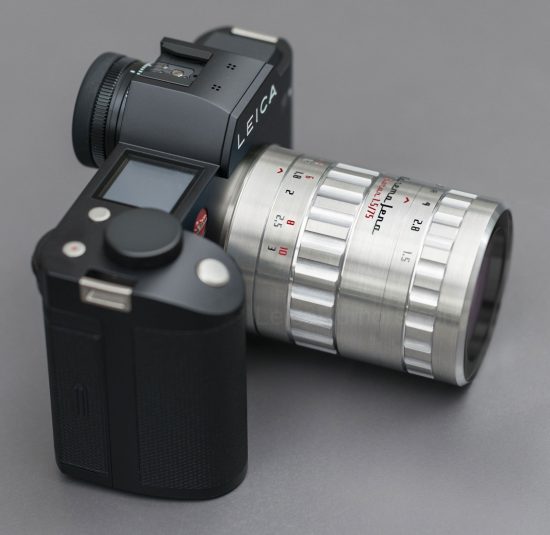Dr. Stefan Immes, who revived the Meyer Optik brand of German lenses three years ago, has launched a new lens company called Opema Jena, which for its first project is bringing back the Biotar 75/f1.5, a lens originally produced by Carl Zeiss. Oprema launched a Kickstarter campaign for the Biotar last week. We talked to Immes about how this new project came about:
Question: Help us clear up the confusion. What exactly is the difference between Meyer Optik and Oprema?
Immes: Both brands are under the same “umbrella” of net SE, the corporate parent which I run in Koblenz, Germany. But apart from that, they are two independent operations. Meyer Optik is focused on resurrecting the old Meyer Optik lenses and building up its production in Germany.
This new venture is actually a collaboration between myself, André de Winter, a renowned former Leica lens designer, Wolf Dieter Prenzel, a leading expert in modernizing classic lenses, and the Japanese lens maker, Tokina.
Oprema Jena will concentrate on bringing back some of the all-time legends that were produced in Jena, Germany before and after the second world war. Production of the Oprema Biotar will be handled by Tokina in Japan. Overseeing the production of the lenses takes a lot of resources and we did not want to overstretch Meyer’s capabilities, so it was important to keep the production of the two companies separate.
Question: While Meyer Optik lenses have been offered with Leica-M mounts, rangefinder coupling has not been available. What is it about the Biotar project that makes rangefinder coupling more feasible? Will Meyer Optik eventually follow suit with rangefinder coupling or is this only something you plan to do with Oprema?
Immes: The focal length of 75 mm is perfect for the rangefinder. It’s also has a historical tie-in because there are some very rare versions of the Biotar with the old Leica screw mount. So, it seemed like a logical choice. Furthermore, because we are working with André, we can be sure that it will be precise and correct.
Question: From a design standpoint, how similar will the original Zeiss Biotar be to this modern version? Will it just share a name or will it have some of the characteristics of the original lens?
Immes: It is important that we differentiate between the optical or image performance and the mechanical design. As far as the image quality or characteristics are concerned, we are striving to be as close as possible to the original. We went through a very detailed process of analyzing the lens in a scientific manner, as well in a more subjective way together with photographers and evaluating literature. Based on these findings, Wolf Dieter designed the optical specs and we tested the outcome. It took a few rounds but now we are very happy that we can say the old Biotar and the new one will be hard to tell apart from looking at the outcome i.e. the images produced.
As far as the mechanical elements or the outer design is concerned, we went a new way. First, we wanted this lens to be modern in regard to the materials and mechanical design used but at the same time have a certain retro touch so that you could tell from the distance that this was not your everyday lens. Also, to be quite honest, the shape of the original Biotar with its "belly" in the middle is not necessarily something we wanted to continue. We wanted a cleaner look. I think when you look at the design, we did a fairly good job. However, some details might change when it comes to serial production.
Question: How did your collaboration with André come about and what is his role is in this project?
Immes: We got in touch with André quite a while ago and he has already been doing some work on the Meyer side. As you know, at Meyer we are working on some very high-end lenses. Together with André, we are designing a line of state of the art lenses for Meyer. We are taking it step-by-step as these lenses are a challenge because of the high-quality materials needed and the painstakingly precise production process, but by 2018 and 2019 we are expecting to be introducing one lens after the other.
Having been working with André it seemed like a logical step to ask him to help design the Biotar. Wolf Dieter Prenzel and André are a perfect team. One is known for his ability to redesign and reengineer historical lenses in a very respectful and sensitive manner -- a true art. The other, André, has a fantastic reputation for his design of the overall lens. He designs the lens around the optical specifications and parameters set by Dr. Prenzel. I can say that his lenses are real beauties. Not only what you see but also the design of all the elements inside are just perfect. There is no question that the new Biotar will be a legend again.
Question: How will Oprema and Meyer Optik lenses differ?
Immes: Meyer has been known for lenses with a lot of bokeh. You can also characterize them as soft focus. They are particularly well suited for portrait and landscape photography of a somewhat dreamy style. At times, soft focus techniques have been unjustly dismissed as “unphotographic,” when, in fact, no other graphic design tools are even remotely capable of achieving this kind of magic, with a wealth of delicate halftones.
Meyer is also in the process of interpreting some older lenses and developing high-end lenses with the newest glasses and aspherical technology. So, there will be the classic designs and the high-tech lenses that push the limits of physical possibilities.
The Oprema lenses will go another direction. We want to identify some of the best lenses of all time that have been neglected by their founders but deserve to be restored. This is, of course, a very personal but also a fun mission. Some fantastic tools for the modern-day photographer should not be forgotten and we intend to bring them back. There’s no question it will be in small quantities but it will be worth it.
Via LeicaRumors






